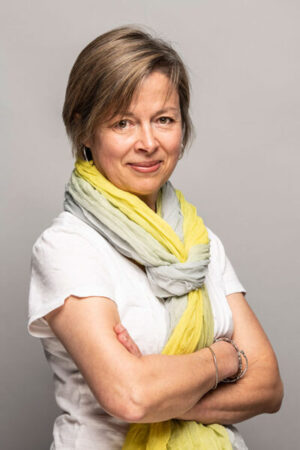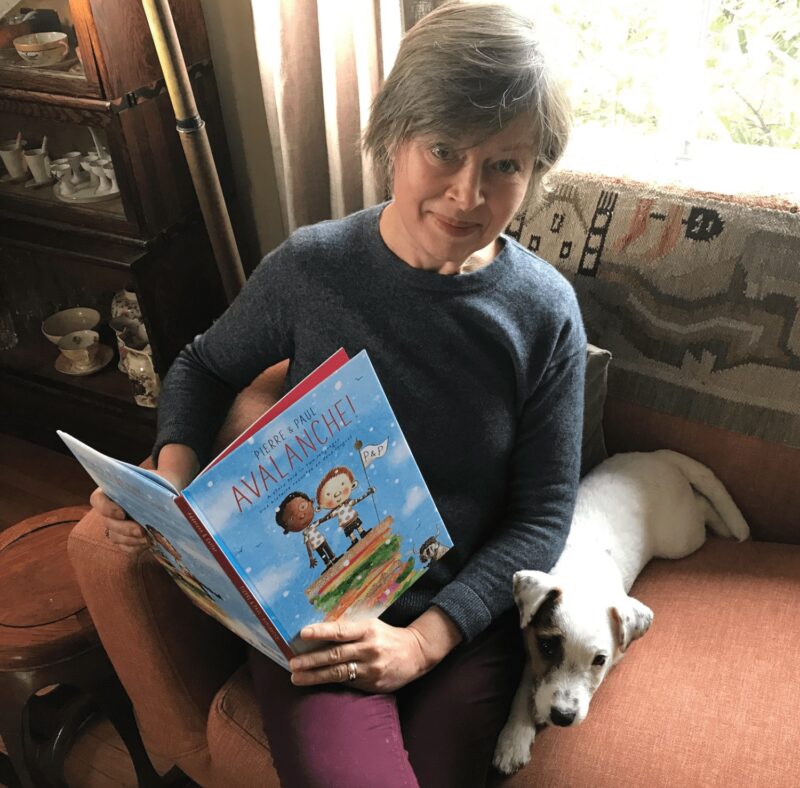1053 An Adderson quartet
Paul & Pierre: Dragon!
by Caroline Adderson, with illustrations by Alice Carter
Toronto: Owlkids Books, 2021
$18.95 / 9781771473286
*
Pierre & Paul: Avalanche!
by Caroline Adderson, illustrations by Alice Carter
Toronto: Owlkids Books, 2020
$18.95 / 9781771473279
*
It Happened on Sweet Street
by Caroline Adderson, illustrations by Stéphane Jorisch
Toronto: Penguin Random House (Tundra Books), 2020
$21.99 / 9781101918852
*
Izzy in the Doghouse
by Caroline Adderson, illustrations by Kelly Collier
Toronto: Kids Can Press, 2020
$15.99 / 9781771387323
*
All books reviewed by Ginny Ratsoy
*

Accomplished west coast novelist, essayist, and editor Caroline Adderson has also penned several books for children of various ages, most notably the Jasper John Dooley series.
The first three books reviewed below — picture books for emerging readers — cleverly introduce French language elements. The first two alternate between English and French; the third seamlessly inserts occasional French idioms. Both approaches seem to be linguistically sound; easing a child into a language, the way Adderson does it, seems natural. All three stories, with their deft, fanciful celebrations of the quotidian neatly matched by clever, appealing visuals, engage young imaginations as they subtly instruct.
The fourth reviewed book is also billed as “for emerging readers;” as a chapter book with a more complex plot and a larger cast of characters, it would, I suspect, most attract older emerging readers, or at least those with a sustained attention span – Ginny Ratsoy
*
 Paul & Pierre: Dragon! reminds young readers of the powers of the imagination and the gems in their own backyard.
Paul & Pierre: Dragon! reminds young readers of the powers of the imagination and the gems in their own backyard.
It is Thursday — garbage day — when friends and explorers Pierre and Paul, one brown and bespectacled and the other white and red-haired, are drawing up their treasure map. As they set off on their quest, each obstacle they encounter activates greater powers of invention. They ward off a dragon, meet a princess who brings Paul back from the dead, wade through a crocodile-infested swamp, cross a forest, encounter a tsunami, and end up back on the terra firma of their neighbourhood – minus the treasure map. Their dismay at being without map (and treasure) is short lived, however, as they discover Treasure Island in the trash. So, their mission is accomplished: they have found treasure in the least likely of places — and given a book a new life, in the process.
*
 The explorer motif is continued in Pierre & Paul: Avalanche! with a quest to climb the Himalayas occupying the minds of the partners in adventure. They have just begun the journey, however, when Paul is overcome by hunger. So, they drop by Pierre’s house for a snack — preferably a sandwich, but anything but a salad, which Paul dislikes.
The explorer motif is continued in Pierre & Paul: Avalanche! with a quest to climb the Himalayas occupying the minds of the partners in adventure. They have just begun the journey, however, when Paul is overcome by hunger. So, they drop by Pierre’s house for a snack — preferably a sandwich, but anything but a salad, which Paul dislikes.
Constructing the sandwich, the pair gets more and more daring and outrageous (and the sandwich more precarious) until they add couscous (after Pierre’s mother cooks it for the purpose). When the couscous makes it too moist, they add cereal to counteract the sogginess. What they end up with is a mountain that spills over the counter, the avalanche forming something that is suspiciously like a salad, but irresistible, nevertheless. The adventure of eating it sates them so much they are too exhausted to climb a mountain. Building and eating a mountain is perilous, tiring work!
Alice Cartier’s vivacious illustrations are integral to Adderson’s quirky narratives. The illustrations function on at least three levels. They explain, complement, and reinforce the action of the plot — particularly helpful on occasions when kids may otherwise find the language with which they are less familiar puzzling. The drawings also bolster the light tone; for example, the boys wear matching mismatched socks. Finally, some of the visuals are rendered as the boys’ own imaginings of their adventures, drawn with a child-like hand; these rudimentary drawings of snorkelling, hot air ballooning, and dragon slaying add a layer that is at once realistic and expressionistic.

*
 In Adderson’s It Happened on Sweet Street, a cul-de-sac in a city of whimsy is the microcosm through with kids can have a vicarious gustatory experience while they receive a lesson in the advantages of cooperation and the necessity of adaptation in an ever-changing society. Monsieur Oliphant in his bakery — located between a shoemaker and a curio shop — creates divine, delectable, works of art in the form of cakes for which eager customers line up. When the shoemaker retires, Oliphant bakes him a boot-shaped cake inhabited by marzipan children. Into the shoemaker’s shop enters Mademoiselle Fée, devoted to marvellous cookie creations, and a rivalry ensues as the neighbourhood line-ups double. Oliphant’s displeasure intensifies — and the rivalry grows bitter — when the china shop owner retires (feted by Monsieur with a gingerbread facsimile of each of her figurines) and her shop is taken over by Madame Clotilde, who concocts scrumptious, other worldly pies.
In Adderson’s It Happened on Sweet Street, a cul-de-sac in a city of whimsy is the microcosm through with kids can have a vicarious gustatory experience while they receive a lesson in the advantages of cooperation and the necessity of adaptation in an ever-changing society. Monsieur Oliphant in his bakery — located between a shoemaker and a curio shop — creates divine, delectable, works of art in the form of cakes for which eager customers line up. When the shoemaker retires, Oliphant bakes him a boot-shaped cake inhabited by marzipan children. Into the shoemaker’s shop enters Mademoiselle Fée, devoted to marvellous cookie creations, and a rivalry ensues as the neighbourhood line-ups double. Oliphant’s displeasure intensifies — and the rivalry grows bitter — when the china shop owner retires (feted by Monsieur with a gingerbread facsimile of each of her figurines) and her shop is taken over by Madame Clotilde, who concocts scrumptious, other worldly pies.
The cul-de-sac is jam-packed with appreciative customers who one day develop a rivalry of their own, as they take sides in the competition. Soon, pies are flying, and dessert mayhem ensues, precipitated by the three competitive proprietors.
To the rescue comes a voice of sanity in the form of a young girl, whose simple yet ingenious solution makes even the bakers see the folly of their ways. Peace is restored, as the inhabitants of the city of whimsy realize that co-existence is possible: it is not a question of competition, but daily personal preference and uniformly superb quality. When the story ends with an ice cream truck pedalling by, readers are left to wonder if the restoration of order is lasting. Here again, Adderson slips in the lessons lightly.
Stéphane Jorisch, a multiple Governor General’s Award recipient, must have had a field day with this assignment. His vivid, over-the-top illustrations are tonally perfect and a delightful complement to the text.
Lessons delivered lightly and illustrations executed inventively. Formidable!
*
 Izzy’s adventures would make for delightful bedtime (or pandemic) reading over a few sittings. In Izzy in the Doghouse, Izzy is a going concern of a child. Imaginative and puzzled at the long list of “don’ts,” she spends more than her fair share of time at school in the principal’s office. When she and her best friend, Zoë, have a spat, she is despondent, despite assurances from Rosa, her nanny, that the rift will be short lived.
Izzy’s adventures would make for delightful bedtime (or pandemic) reading over a few sittings. In Izzy in the Doghouse, Izzy is a going concern of a child. Imaginative and puzzled at the long list of “don’ts,” she spends more than her fair share of time at school in the principal’s office. When she and her best friend, Zoë, have a spat, she is despondent, despite assurances from Rosa, her nanny, that the rift will be short lived.
When her mother returns from a business trip, she treats Izzy to her favourite story — a story-within-a story that provides readers with Izzy’s back story. Her mother recounts the anguish she went through waiting to adopt Izzy. It is a story Izzy knows well and loves: after endless waiting and much bureaucracy, mother was notified on her work phone that Izzy was born. The adoption conversation was interrupted by a fire drill, but mom was too excited to evacuate and had to be carried out of the building.

The next two days are an emotional roller coaster for our heroine. Mother and daughter are supposed to play hooky together. But when mom heeds the siren call of work, Izzy is forced to go to school late, discovering, to her dismay, that Zoë is still angry with her. The following day, due to a successful intervention by Rosa, the household trio go to a dog agency and emerge with puppy Rollo. Relating the situation to her own adoption, Izzy assumes the maternal role, in which she copes with being peed on and with a canine aversion to the sounds of household bells.
After a busy weekend taking care of her baby, Izzy returns to school to find Zoë no longer mad at her. When Rosa picks her up with the puppy in tow, Izzy invites Zoë home. Once the girls exhaust Rollo, they get so involved in their own playing that it takes them a while to notice that Rollo has exited his cage. The girls are frantic; even Rosa cannot find him. Then, in a flash of brilliance, Izzy simultaneously calls the landline from her cell phone and sets off the microwave bell, and in comes Rollo. When Rollo and Izzy walk Zoë home, the latter professes her love for both of them. That night, Rollo whimpers in his cage and Izzy takes him outside. Mom, alarmed to see her daughter’s room empty, finds them outside, joins them, and all is right in their world.
Collier’s black and white illustrations highlight the book’s humour and add an appealingly old-fashioned quality to the text.
With wide ranging emotions and frequent hilarity, Izzy in the Doghouse teaches kids about adoption, the responsibilities of child and pet care, non-traditional families, and the sometimes rocky road of friendship. It might also remind adults that children’s emotional highs and lows, while they can seem petty to onlookers, are very real to them.
*

Ginny Ratsoy writes, bakes, teaches and finds treasures in Kamloops. She is currently involved in a project that has her reading a mountain of books. Her latest academic publication is about a wonderful third-age learning organization, The Kamloops Adult Learners Society, (KALS) in No Straight Lines: Local Leadership and the Path from Government to Government in Small Cities, edited by Terry Kading (University of Calgary Press, 2018), reviewed by Michael Lait in The Ormsby Review. She is delighted to add that her recent retirement from academia has made it possible for her to join the board of directors of KALS, for whom she has instructed since 2007. Editor’s note: Ginny Ratsoy’s recent reviews include books by Melanie Jackson, Estella Kuchta, Madeline Sonik, Mary MacDonald, Lauren Soloy, Nick Tooke, Alix Ohlin, Steven Price, and Sarah Louise Butler.
*
The Ormsby Review. More Books. More Reviews. More Often.
Publisher and Editor: Richard Mackie
The Ormsby Review is a journal service for in-depth coverage of B.C. books and authors. The Advisory Board consists of Jean Barman, Wade Davis, Robin Fisher, Cole Harris, Hugh Johnston, Patricia Roy, David Stouck, Maria Tippett, and Graeme Wynn. Scholarly Patron: SFU Graduate Liberal Studies. Honorary Patron: Yosef Wosk. Provincial Government Patron since September 2018: Creative BC
“Only connect.” – E.M. Forster

2 comments on “1053 An Adderson quartet”